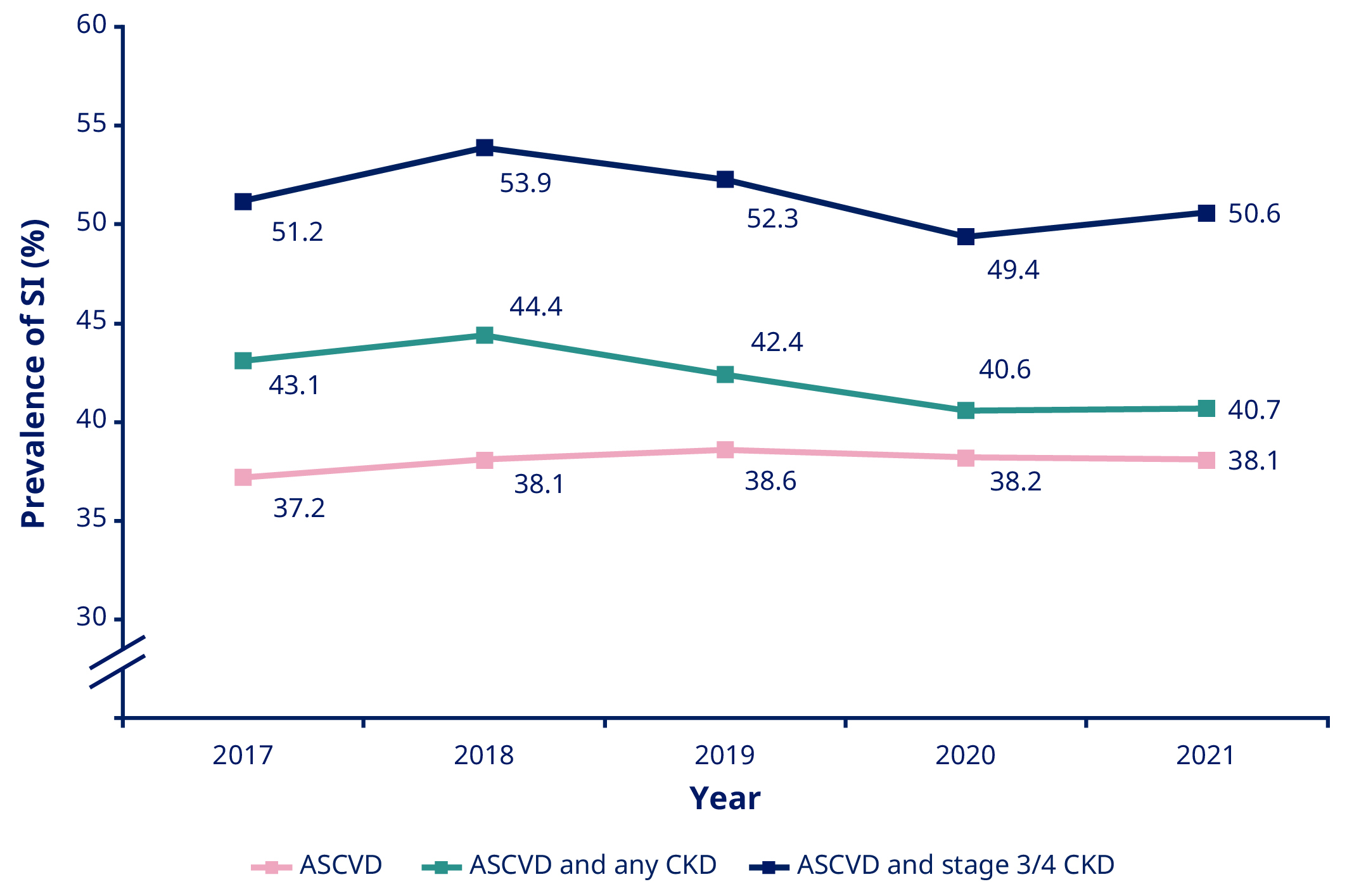Final ID: Mo1004
Prevalence and Clinical Characteristics of US Patients with Systemic Inflammation and Atherosclerotic Cardiovascular Disease With or Without Chronic Kidney Disease
Abstract Body (Do not enter title and authors here): Background: High-sensitivity C-reactive protein (hsCRP) is a well-established biomarker of inflammation. Systemic inflammation is a recognized risk factor for atherosclerotic cardiovascular disease (ASCVD); however, the prevalence of systemic inflammation (SI) and the associated patient characteristics remain unknown.
Aim: To define the prevalence and clinical characteristics of patients with SI and ASCVD with or without chronic kidney disease (CKD).
Methods: A retrospective cross-sectional analysis of US adults (aged ≥18 years) with any diagnoses of ASCVD evaluated with a hsCRP test using the Optum® de-identified electronic health record dataset between 2017 and 2021. SI was defined as an hsCRP level of 2–10 mg/L. The prevalence of SI was evaluated by calendar year, stratified to three groups by presence of ASCVD, ASCVD with any stage of CKD, and ASCVD with stage 3 or 4 CKD. Concomitant comorbidities and medications used were assessed and stratified by CKD severity.
Results: Across the study period, prevalence of hsCRP testing among patients with ASCVD remained relatively stable (0.87–0.98%). Among patients who underwent hsCRP testing, SI was present in 38.0%, 42.3% and 51.5% of patients with ASCVD, ASCVD with CKD, and ASCVD with stage 3 or 4 CKD averaged across the study period, respectively (Figure 1). The prevalence of SI remained largely unchanged over the study period across the three groups (Figure 1). Among those with SI, a higher Charlson Comorbidity Index was noted in those with CKD: 0.75–0.78 in those with ASCVD, 0.99–1.21 in those with ASCVD and CKD, and 1.71–1.89 in those with ASCVD and stage 3 or 4 CKD. The most common medications utilized in those with SI were lipid-lowering therapy (70.5% [ASCVD], 72.7% [ASCVD with any CKD] and 75.4% [ASCVD with stage 3 or 4 CKD]) and antihypertensive therapy (72.8% [ASCVD], 79.3% [ASCVD with any CKD] and 86.7% [ASCVD with stage 3 or 4 CKD]) averaged across the study period.
Conclusion: Among patients with ASCVD undergoing hsCRP testing, SI was common, particularly among those with stage 3 or 4 CKD. This finding may help identify at-risk individuals who are likely to benefit from treatment of SI.
Aim: To define the prevalence and clinical characteristics of patients with SI and ASCVD with or without chronic kidney disease (CKD).
Methods: A retrospective cross-sectional analysis of US adults (aged ≥18 years) with any diagnoses of ASCVD evaluated with a hsCRP test using the Optum® de-identified electronic health record dataset between 2017 and 2021. SI was defined as an hsCRP level of 2–10 mg/L. The prevalence of SI was evaluated by calendar year, stratified to three groups by presence of ASCVD, ASCVD with any stage of CKD, and ASCVD with stage 3 or 4 CKD. Concomitant comorbidities and medications used were assessed and stratified by CKD severity.
Results: Across the study period, prevalence of hsCRP testing among patients with ASCVD remained relatively stable (0.87–0.98%). Among patients who underwent hsCRP testing, SI was present in 38.0%, 42.3% and 51.5% of patients with ASCVD, ASCVD with CKD, and ASCVD with stage 3 or 4 CKD averaged across the study period, respectively (Figure 1). The prevalence of SI remained largely unchanged over the study period across the three groups (Figure 1). Among those with SI, a higher Charlson Comorbidity Index was noted in those with CKD: 0.75–0.78 in those with ASCVD, 0.99–1.21 in those with ASCVD and CKD, and 1.71–1.89 in those with ASCVD and stage 3 or 4 CKD. The most common medications utilized in those with SI were lipid-lowering therapy (70.5% [ASCVD], 72.7% [ASCVD with any CKD] and 75.4% [ASCVD with stage 3 or 4 CKD]) and antihypertensive therapy (72.8% [ASCVD], 79.3% [ASCVD with any CKD] and 86.7% [ASCVD with stage 3 or 4 CKD]) averaged across the study period.
Conclusion: Among patients with ASCVD undergoing hsCRP testing, SI was common, particularly among those with stage 3 or 4 CKD. This finding may help identify at-risk individuals who are likely to benefit from treatment of SI.
More abstracts on this topic:
A hepatic steatosis-mediated metabolite reprograms macrophage lipid metabolism and aggravates atherosclerosis
Long Ting, Feng Ruijia, Feng Weiqi, Peng Guiyan, Yang Wenchao, Li Zilun, Huang Kan, Chang Guangqi
A Focus for Improvement - Factors for Lab Adherence in a Pediatric Preventive Cardiology ProgramHolsinger Hunter, Porterfield Ronna, Taylor Makenna, Dresbach Bethany, Seipel Brittany, Igwe Chukwuemeka, Alvarado Chance, Tran Andrew

